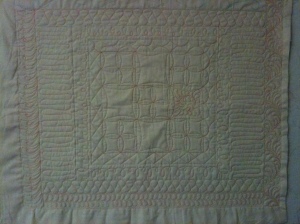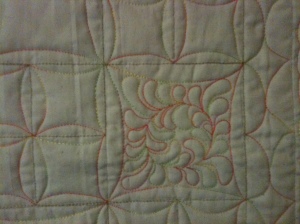Posts tagged ‘fear of failure’
The Rest of My Classes at QwM 2011
Continuing my story…
Friday afternoon and Saturday morning were devoted to my two hands-on domestic sewing machine quilting classes. I feel almost honor-bound to take as many of these as the powers that be at QwM will offer, as I want to do my part to make sure they keep offering them. It also gives me the opportunity to meet, and therefore evangelize to, my fellow DSM quilters who may not know that any of the design-type classes are equally applicable to them as to the more numerous longarm quilters in attendance. We may have to sit through some minor references to canvas leaders and advancing the machine and so forth, but I use that time to meditate about how I can quilt in any direction I choose, for as long a distance as my quilt requires, and how my dining room still has a table in it. Kidding, of course, but Leah Day had an excellent post recently on Seven Reasons Why I Don’t Want or Need a Longarm, which was exactly what I needed to galvanize me pre-QwM against feelings of machine inadequacy. She reinforced the fact that quality machine quilting is possible on a DSM even if you’re not Ricky Tims/ Diane Gaudynski/ Lee Cleland/ Patsy Thompson/ Barbara Shapel/ Karen Kay Buckley/ Caryl Bryer Fallert/ Hollis Chatelain. Don’t get me wrong; if I walked downstairs tomorrow morning to discover that my house had magically grown an extra room with a longarm quilting machine in it, I wouldn’t turn up my nose. But in the real, non-magical world, that’s a huge investment for a huge machine that I’d only use for my own quilts, and buying one wouldn’t automatically turn me into a better quilter, just one with no dining room and a big payment to make every month. The learning curve is still paramount, and the big machine isn’t a shortcut around practicing.
OK, off the soapbox and on to what I did in class. The first was “Freehand Feathers” with Beth Schillig, who has had quilts at Houston and Paducah and used to be a Bernina dealer near Columbus. She was a kind, patient, generous teacher who showed us several feather styles I hadn’t tried before, and I was very happy to have produced these doodle cloths in a four-hour class:
(Click on the pictures to zoom in if you need to, photographing wholecloths is hard.)
The next morning I had “Becoming a Domestic Diva Part 2” with Penny Roberts, who is primarily a longarm quilter and inventor of longarm gadgets, but keeps her hand in with DSM quilting and was an excellent teacher with a well-thought-out lesson plan. She provided us with a pre-“stitched in the ditch” sample so we could concentrate on the free-motion fun stuff. When she started with continuous curve, I was concerned I had taken too beginner-y a class, but I quickly came to realize that my current lifestyle doesn’t really allow me much time to just play and experiment with my quilting; I always feel like I have to make every minute count so I have to accomplish! Taking these classes was like the “spontaneous activity in a prepared environment” concept from Montessori school: it gave me permission to just goof off with my machine, and I definitely feel the value of the experience. As you see:
Not to mention, through all that in-class quilting, I did not have a single problem with my machine! Not one! I certainly hope this augurs well for the future.
Saturday afternoon, feeling more than a little fried, I finished up with “But How Should I Quilt This?” with Debby Brown. While the class was excellent, the most valuable thing I took from it was finding Debby! She was not someone whose reputation I knew before taking her class, and I’ve greatly enjoyed perusing her blog and checking out her free online videos and tutorials. She was an entertaining lecturer, and really synthesized a great deal of disparate information into a fairly coherent system for helping the quilter focus on a few complementary designs to successfully quilt each top.
This spoke very centrally to my recurrent problem of Analysis Paralysis when it comes to quilting my own quilts: I fall for the fallacy that there is only one way to “correctly” quilt the quilt, and if I don’t find it, the quilt will be a failure. Debby rationally and rightly pointed out that the first step to quilting a top is to simply make a decision. Her next words stopped me in my mental tracks and made me write them down: “Sometimes it’ll be just good enough, but sometimes it’ll be perfect.” I think the reason I found that simple statement to be so profound (aside from sheer mental and physical exhaustion) is what she didn’t say, but I’ve apparently believed to be true, that there is no acceptable alternative to perfection. And the secret, of course, is that there is. There’s good enough. There’s quite nice. There’s really special. What there is not, is COMPLETELY UNACCEPTABLE OH MY GOSH YOU RUINED YOUR QUILT. Because even crappy quilting results in…A QUILT! Not a top sitting in a box, waiting to be sold in (hopefully) many decades in my estate sale, but a quilt, that gets used and loved. That keeps the baby warm. That gives the cat a place to sleep. That lets me see that fabric I absolutely had to have. That goes to show and tell and hangs in the guild show and maybe gets given as a gift to wrap the people I love in the longest-lasting hug I know how to give. A top can’t do any of that, and it’s not a quilt until it’s quilted.
So I’m going to go quilt those tops. I’ll keep perfection on the horizon, but I’ll try to keep perfectionism at bay. Let’s go make some good enough quilts.









